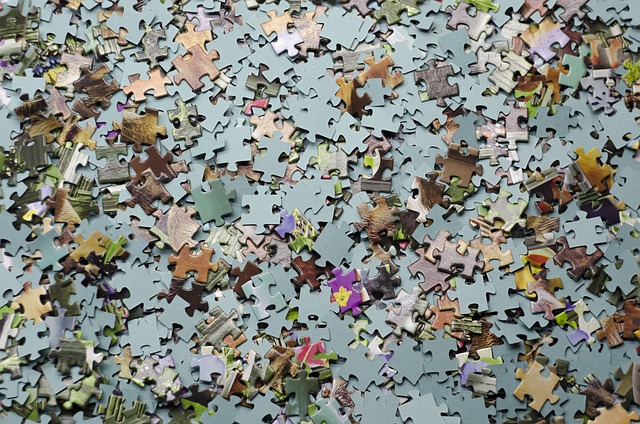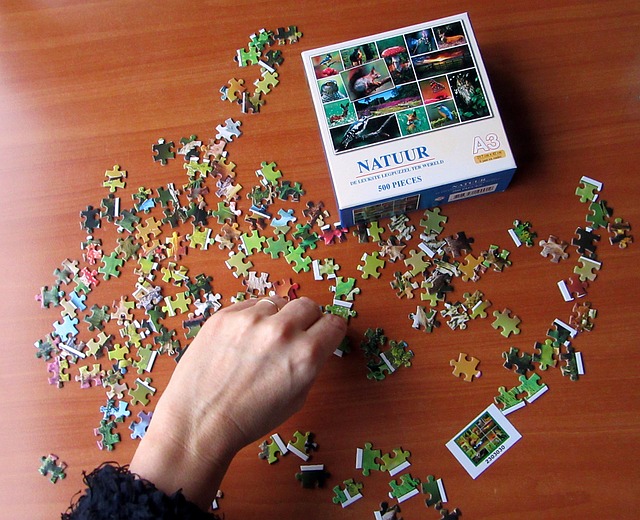Last Updated on February 16, 2024 by JigsawPuzzleGuru
Table of Contents
A Step-by-Step Guide
Selecting the appropriate puzzle to match one’s skill level is a crucial step in ensuring a challenging yet enjoyable puzzling experience. Beginners might find themselves overwhelmed by a high piece count or complex imagery, while seasoned enthusiasts may seek greater difficulty to maintain their interest. It’s important to consider several factors, including the number of pieces, puzzle type, and image complexity when making a selection. This guide will help you know how to choose the right puzzle for your skill level.
For someone new to puzzles, starting with a lower piece count, typically ranging from 100 to 300 pieces, is beneficial. These puzzles usually offer simpler images with distinct color sections, making it easier to discern where each piece fits. As individuals become more adept at piecing puzzles together, they can gradually increase the number of pieces, moving up to puzzles with 500, 1000, or even 2000 pieces for an added challenge.
Different types of puzzles also cater to various skill levels. Traditional jigsaw puzzles are the most common and come in a wide range of difficulties. 3D puzzles and brain teasers, on the other hand, may introduce unique problem-solving elements that require spatial reasoning and logic, offering a different kind of challenge that goes beyond the mere sorting and fitting of pieces. Matching one’s skill level with the right puzzle is not just about the piece count but also involves considering the type and intricacy of the puzzle.
Understanding Puzzle Types and Materials
Selecting the right puzzle involves knowing the different types of puzzles and the materials they are made of. Quality and thematic significance should inform your choice to ensure an enjoyable puzzling experience.

Distinguishing Between Puzzle Types
Puzzles come in various forms, each offering a unique challenge. Jigsaw puzzles are highly popular and vary in difficulty based on the number of pieces and the complexity of the image; they range from straightforward for beginners to complex for experts. 3D puzzles offer a spatial and tactile challenge, creating three-dimensional structures, sometimes of famous buildings or objects. Both types come in an array of themes and designs, catering to a wide range of interests and skill levels.
Assessing Material Quality
Materials greatly influence the durability and the feel of a puzzle. Wooden puzzles represent a classic choice known for their sturdiness and pleasing texture. They often feature intricate cut designs and can be more challenging due to the heft and fit of the pieces. Plastic and cardboard are common materials for jigsaw and 3D puzzles, but their quality varies. High-quality puzzles have firm, well-fitting pieces that interlock smoothly, while lower-quality versions might have pieces that bend or wear out quickly. When assessing materials, one should check for durability, texture, and how well the pieces stay together.
Selecting Puzzles by Skill Level
Choosing the right puzzle involves matching the puzzle’s complexity with the puzzler’s skill level, ensuring a balance between challenge and enjoyment.
Puzzles for Beginners
For beginners, it is crucial to start with puzzles that have a lower number of pieces and simple imagery. These criteria help prevent frustration and encourage the development of basic puzzling skills.
- Complexity: Look for puzzles ranging from 24 to 300 pieces.
- Imagery: Choose puzzles with large, distinct sections of color or patterns, which make assembly easier.
Challenges for Experienced Puzzlers
Experienced puzzlers may find puzzles with higher piece counts or irregular edges more satisfying due to their increased level of difficulty. Puzzles that incorporate intricate details or repetitive patterns present a worthwhile challenge.
- Difficulty Levels: Puzzles can range anywhere from 500 to over 2000 pieces.
- Design Complexity: Opt for puzzles featuring complex artwork or those that lack visual cues, such as monochromatic colors or repeating patterns.

Considering Puzzle Size and Piece Count
When selecting a puzzle, understanding the relationship between puzzle size and piece count is crucial. The number of pieces and their size can significantly affect the difficulty and enjoyment of the puzzle-building experience.
Benefits of Large Piece Puzzles
Large piece puzzles are often ideal for beginners or those with limited dexterity. With fewer pieces to handle, they are easier to manage and can build confidence:
- Visibility: Larger pieces are more visible and easier to distinguish.
- Handling: They are simpler to pick up, place, and fit together.
For instance, a puzzle with 500 large pieces might cover the same area as a 1000-piece puzzle with smaller pieces.
Rewards of Intricate Designs
Intricate designs in puzzles, particularly those with a 1000-piece count or more, offer a distinct set of rewards:
- Detail: More pieces allow for greater detail and a more satisfying image upon completion.
- Challenge: The complexity of smaller pieces requires more precise sorting and placement, offering a more challenging and engaging experience.
It is important to match a puzzle’s size and piece count to an individual’s skill level.
Factors Impacting How to Choose the Right Puzzle for Your Skill Level
Choosing the right puzzle requires a careful evaluation of personal preferences and the insights offered by reviews. These factors guide a puzzler to a decision that aligns with their skill level and enjoyment.
Identifying Personal Preferences
Age: A person’s age is a significant factor in selecting puzzles. Puzzles are often rated by age appropriateness, ranging from simple shapes for toddlers to complex designs for adults.
Interest and Motivation: A puzzler’s interests play a crucial role in maintaining motivation. Selecting themes that align with one’s hobbies can enhance engagement.

- Examples include puzzles featuring:
- Nature landscapes for outdoor enthusiasts
- Art replicas for art lovers
- Mechanical designs for engineering buffs
Time Availability: The amount of time a person can dedicate to puzzling should influence the complexity of the puzzle chosen.
- Considerations include:
- Number of pieces: Ranges from under 100 for a quick session to over 1000 for longer, more challenging engagements.
- Estimated completion time: Provided by manufacturers to gauge time commitment.
Influence of Puzzle Reviews
Reviews and Recommendations: Reviews can heavily impact puzzle choice. They provide insight into the puzzle’s quality, design, and level of challenge.
- Key review aspects to consider:
- Difficulty level as compared to claimed skill level
- Piece quality and fit
- Image clarity and print accuracy
Trustworthiness: The source of the review is as important as its content. Prospective buyers should look for reviews from established puzzle enthusiasts or reputable sources to ensure they get an accurate idea of the puzzle’s attributes.
No you know how to choose the right puzzle for your skill level!
